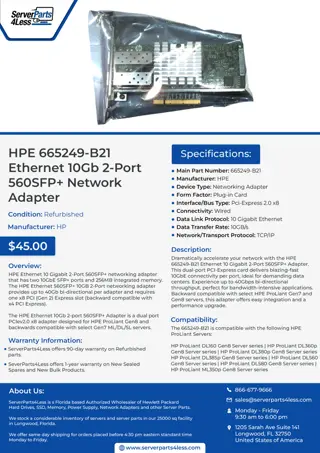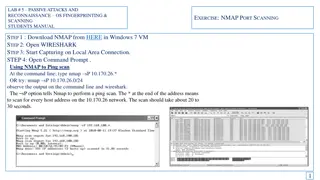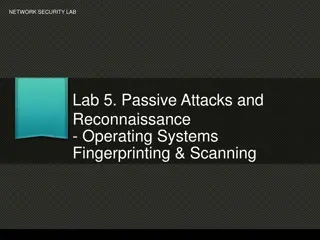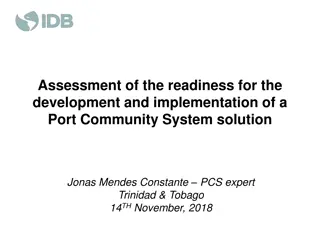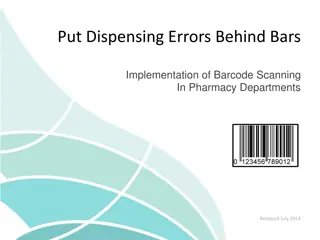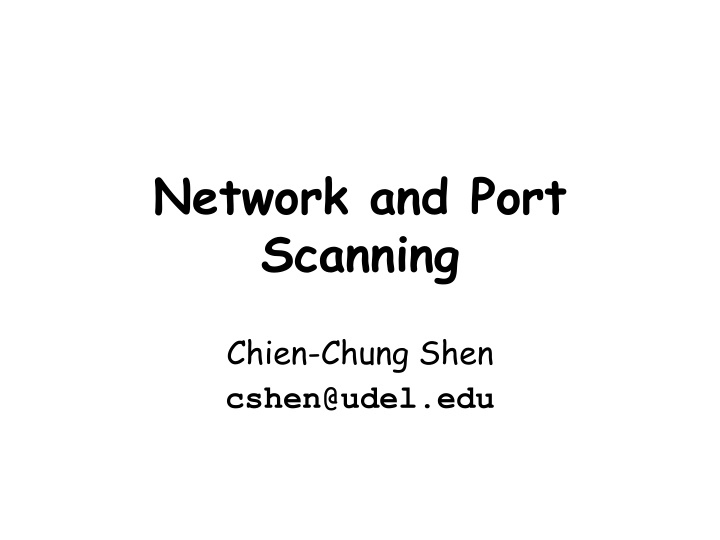
Understanding Network and Port Scanning Techniques
Explore the essentials of network reconnaissance, host discovery, IP addressing, port scanning, TCP segments, 3-way handshake, and more to enhance your understanding of networking protocols and security measures.
Download Presentation

Please find below an Image/Link to download the presentation.
The content on the website is provided AS IS for your information and personal use only. It may not be sold, licensed, or shared on other websites without obtaining consent from the author. If you encounter any issues during the download, it is possible that the publisher has removed the file from their server.
You are allowed to download the files provided on this website for personal or commercial use, subject to the condition that they are used lawfully. All files are the property of their respective owners.
The content on the website is provided AS IS for your information and personal use only. It may not be sold, licensed, or shared on other websites without obtaining consent from the author.
E N D
Presentation Transcript
Network and Port Scanning Chien-Chung Shen cshen@udel.edu
Host Discovery One of very first steps in network reconnaissance mission to reduce a (sometimes huge) set of IP ranges into a list of active or interesting hosts administrator uses an ICMP ping to locate hosts on internal network external penetration uses a diverse set of probes in an attempt to evade firewall restrictions Aka ping scan, but goes beyond ICMP echo request packets
IP Address 3 2 B i t s R a n g e o f h o s t a d d r e s s e s 1 . 0 . 0 . 0 t o 1 2 7 . 2 5 5 . 2 5 5 . 2 5 5 C l a s s A 0 N e t w o r k H o s t 1 2 8 . 0 . 0 . 0 t o 1 9 1 . 2 5 5 . 2 5 5 . 2 5 5 1 9 2 . 0 . 0 . 0 t o 2 2 3 . 2 5 5 . 2 5 5 . 2 5 5 2 2 4 . 0 . 0 . 0 t o 2 3 9 . 2 5 5 . 2 5 5 . 2 5 5 2 4 0 . 0 . 0 . 0 t o 2 4 7 . 2 5 5 . 2 5 5 . 2 5 5 B 1 0 N e t w o r k H o s t C 1 1 0 N e t w o r k H o s t D 1 1 1 0 M u l t i c a s t a d d r e s s E 1 1 1 1 0 R e s e r v e d f o r f u t u r e u s e $ nslookup stimpy.cis.udel.edu 128.4.31.17 is a class B address strauss.udel.edu 128.175.13.74 $ nmap -sL 128.4.0.0/16 > a Locate 128.4.21.33
Port Scanning In TCP/IP, every (network) service on a machine is assigned a port (number) On Unix machine, ports assigned to standard services are listed in /etc/services There is a (Unix) process listens on the port for incoming connection requests What is the port # of ssh? Goal of port scanning: find out which ports are open, closed, or filtered e.g., find out if a remote host is providing a service that is vulnerable to buffer overflow attack port scanning may involve all 65,535 ports or only the ports that are well-known to provide services vulnerable to security-related exploits
TCP Segment 32 bits source port # sequence number acknowledgement number head len used dest port # ACK not receive window U A P R S F checksum Urg data pointer RST, SYN options (variable length) application data (variable length)
TCP 3-Way Handshake Client Server SYN bit=1, Seq=x SYN bit=1, Seq=y ACK bit=1; ACKnum=x+1 ACK bit=1, ACKnum=y+1
Port Scanning A port is open on a machine if there is a running (server) process on the machine and the port is assigned to this process if a port on a remote host is open for incoming connection requests and you send it a SYN packet, the remote host will respond back with a SYN+ACK packet A port is filtered if packets passing through that port are subject to filtering rules of a firewall if a port is filtered with something like an iptables based packet filter and you send it a SYN packet or an ICMP ping packet, you may not get back anything at all If a port on a remote host is closed and you send it a SYN packet, the remote host will respond back with a RST packet
connect (TCP) Scan Check out man page of connect() #include <sys/socket.h> int connect(int socketfd, // file descriptor from socket() const struct sockaddr *address, // server IP address socklen_t address_len); A call to connect() if successful completes a three- way handshake for a TCP connection with a server In a typical use of connect() for port scanning, if the connection succeeds, the port scanner immediately closes (via close()) the connection (having ascertained that the port is open) to avoid DoS attack
Socket application process application process socket controlled by app developer transport transport controlled by OS network network link link Internet physical physical door between application process and TCP transport protocol
Port Scanner in Python Port Scanner in Python Using built-in socket module $ python port-scanner.py Nmap module/library in Python python-nmap: nmap from python python-libnmap 0.7.0
Port Scanning with (TCP) SYN (1) Most popular form of port scanning Open TCP connection via three-way handshake SYN -> SYN+ACK -> ACK In port scanning with SYN packets, scanner sends out SYN packets to different ports of a remote machine. When scanner receives SYN+ACK packet in return for a given port, scanner can be sure that the port on remote machine is open it is the duty of a good port-scanner to immediately send back RST packet in response to received SYN+ACK packet so that the half-open TCP connection at remote machine is closed immediately
Port Scanning with TCP SYN (2) When a target machine receives a SYN packet for a closed port, it sends back an RST packet back to the sender When a target machine is protected by a packet-level firewall, it is the firewall rules that decide what the machine s response will be to a received SYN packet
connect() vs. SYN SYN port scanner generates raw IP packets itself, and monitors for responses aka "half-open scanning", because it never actually opens a full TCP connection SYN scan has advantage that individual services never actually receive a connection (less intrusive?) connect() use operating system's network functions full TCP connection established
UDP Scan (1) SYN packet is a TCP concept In a UDP scan, if a UDP packet is sent to a port that is not open, the remote machine will respond with an ICMP port-unreachable message. So the absence of a returned message can be inferred as a sign of an open UDP port A packet filtering firewall at a remote machine may prevent the machine from responding with an ICMP error message even when a port is closed
UDP Scan (2) Send application-specific UDP packets, hoping to generate application layer response e.g., sending DNS query to port 53 will result in a response, if DNS server is present limited to scanning ports for which an application specific probe packet is available
nmap Network Mapper Open-source nmapstands for network mapper (http://nmap.org) nmap is more than just a port scanner listing open ports on a network trying to construct an inventory of all services running in a network trying to detect as to which operating system is running on each machine nmap can carry out TCP SYN scan, TCP connect() scans, UDP scans, ICMP scans, etc.
nmap As listed in manpage, nmap comes with a large number of options for carrying out different security scans of a network -sT:carries out a TCP connect() scan -sU: sends a dataless UDP header to every port (state of the port is inferred from the ICMP response packet [if there is such a response at all])
nmap -sP: ping scanning to determine which machines are up in a network nmap sends out ICMP echo request packets to every IP address in a network. Hosts that respond are up But this does not always work since many sites now block echo request packets. To get around this, nmap can also send a TCP ACK packet to (by default) port 80. If the remote machine responds with an RST back, then that machine is up Another possibility is to send the remote machine a SYN packet and waiting for an RST or a SYN/ACK. For root users, nmap uses both ICMP and ACK techniques in parallel. For non-root users, only the TCP connect()is used -sV: version detection After nmap figures out which TCP and/or UDP ports are open, it next tries to figure out what service is actually running those ports In addition to determine the service protocol (http, ftp, ssh, telnet, etc.), nmap also tries to determine the application name (such as Apache httpd, ISC bind, Solaris telnetd, etc.), version number, etc.
Port Scan Examples (sudo) nmap -sS localhost SYNscan nmap sS stimpy.cis.udel.edu nmap sS A stimpy.cis.udel.edu aggressive or advanced If the target machine has the DenyHosts shield running and you repeatedly scan that machine with -A turned on, your IP address may become quarantined on the target machine (assuming that port 22 is included in the range of the ports scanned). When that happens, you will not be able to SSH into the target machine
nmap By default, nmap first pings a remote host in a network before scanning the host. The idea is that if the machine is down, why waste time by scanning all its ports Since many sites now block/filter ping echo request packets, this strategy may bypass machines that may otherwise be up in a network To change this behavior, the following nmap may produce richer results nmap -sS -A P0 <host> -P0: skip pinging
nmap nmap can make good guess of the OS running on the target machine by using TCP/IP stack fingerprinting It sends out a series of TCP and UDP packets to the target machine and examines content of returned packets for values in various header fields, including sequence number, initial window size, etc. Based on these values, nmapthen constructs an OS signature of the target machine and sends it to a database of such signatures to make a guess about the OS running on the target machine
Firewall/IDS Evasion/Spoofing Network obstructions such as firewalls can make mapping a network exceedingly difficult All of the major IDSs ship with rules designed to detect Nmap scans because scans are sometimes a precursor to attacks Many of these products have recently morphed into intrusion prevention systems (IPS) that actively block traffic deemed malicious https://nmap.org/book/man-bypass-firewalls-ids.html




